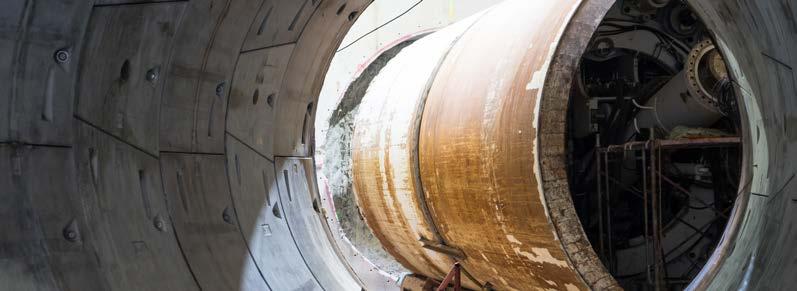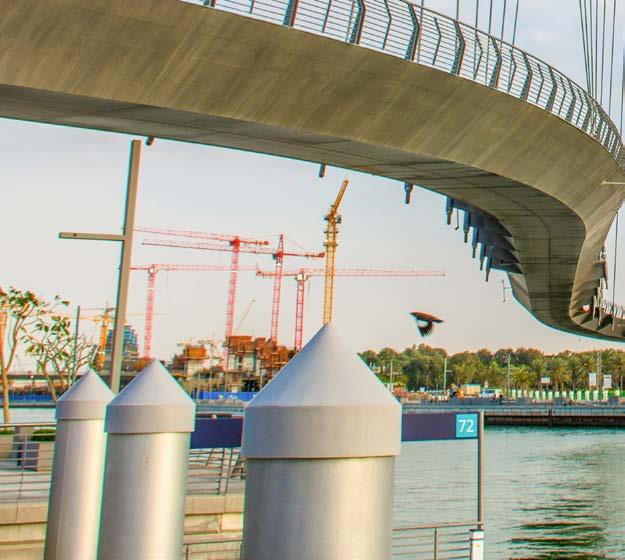

Changing the Narrative
An analysis of claims and dispute causation on engineering and construction projects


Foreword
As a global consultancy mitigating risk, resolving disputes and supporting litigation, HKA’s work provides deep and unmatched insights into what goes wrong on major capital projects worldwide.
The CRUX integrated research programme taps this knowledge base by analysing the causes of claims and disputes investigated first-hand by our specialist consultants. Our annual CRUX Insight Report shares that intelligence.
In the years following the global pandemic, heightened geopolitical uncertainties and economic shocks have distorted the myriad pressures and challenges project stakeholders face. Yet, the most prevalent causes of claims and disputes are recurrent. They stem from repeated underlying failures tracked by CRUX over the years.
This is a damaging pattern the capital projects and infrastructure sector needs to change. Our report this year places greater emphasis than ever on the steps that can be taken and changes made to achieve better outcomes for projects and their participants. Hence its title, Changing the Narrative. The recommendations we make are informed by our multidisciplinary specialists and their work in not only resolving disputes, but also providing advisory services at critical stages of the project lifecycle.
Clusters of causes
We have framed this year’s analysis by focussing on critical clusters of interrelated causes of project distress revealed by CRUX. These five chapters explore: contractual conflicts, the desire to ‘speed the build’, stakeholders’ behaviours, skills-related challenges, and the growing environmental risks facing projects.
Our consultants explore the drivers and impacts of these factors and set out recommendations for breaking the cycle of under-performance leading to cost and schedule overruns. Case studies add further insights into how these problems can and should be anticipated and resolved in practice.
As before, CRUX Insight begins with an overview of the patterns of causation globally and by region. But for the first time, we have added an econometric analysis (page 59 the relationships between the direct causes of project distress and the wider economic context.
The knowledge to be gained from our unparalleled database extends beyond this report. The CRUX Insight Interactive Dashboard is an open resource that you and colleagues can use to shed further light on the patterns of claims and disputes in your market or a particular jurisdiction, and to benchmark performance or re-calibrate risks.
We will also continue to share our insights with clients and – through seminars and other events – with professional bodies, legal firms, and stakeholders across the global construction and engineering industry.
It is our firm belief that risks on infrastructure and capital projects can be mitigated more effectively. This is the purpose of our research and analysis. I trust that the Seventh Annual CRUX Insight Report and your engagement with these issues will contribute to that goal.

Renny Borhan Partner, Chief Executive Officer



Our report places greater emphasis than ever on the steps and changes needed to achieve better outcomes for projects.

Overview
What are the most pervasive causes of claims and disputes worldwide? How do they impact infrastructure and capital projects? And how can the industry use this knowledge to mitigate risk and achieve better project outcomes?
These are the questions that CRUX –our integrated research programme –is designed to answer.
Dataset
Data on more than 2,000 projects has now been captured within this unique database, which draws on the first-hand investigations of HKA consultants. Just over 200 projects were added between last year’s report and the June 2024 cut-off for this latest analysis.
Our seventh annual CRUX Insight report covers projects in 107 countries with a combined capital expenditure (CapEx) value of US$ 2.254 trillion. 1 A significant proportion were megaprojects: the average CapEx budget was $1.28 billion.
Impacts
At a time when these capital costs are being inflated due to economic conditions, many projects also paid a heavy price for conflicts among their promoters and parties responsible for delivery. The total value of sums in dispute on the 2,002 projects analysed was $84.4 billion. In terms of time, the cumulative length of extensions sought by contractors would reach beyond 994 years.
The extent of the damage done by claims and disputes is more readily apparent at project level. Additional costs claimed amounted, on average, to just under a third (33.2%) of a contract’s budgeted CapEx. Planned schedules typically face an overrun of close to two thirds (66.5%) or around 16 months.
Causes
A constant in CRUX – and most other research into the performance of construction and engineering projects – is the near-universal pre-eminence of change in scope as a source of claims and disputes. This top factor in the global ranking affected 36.9% of projects.
1 All values throughout this report are expressed in US dollars

Last year’s report highlighted how design-related failings were driving project distress, directly and in conjunction with scope change. That causation is now even more evident as the design-related ‘trio’ – incorrect design (21.5% of projects), late design information (21.3%), and incomplete design (19.8%) – ranked as the most common factors after scope change. Failure in contract management and/or administration was the other top-five factor, affecting 18.0% of projects (previously 19.8%).
Mega-disrupters
CRUX exposes variations in the pattern of claims and disputes between regions and project types. However, the analysis also confirms that the same problems recur across the years, sectors and borders – and how clusters of interrelated clauses are associated with some of the greatest challenges facing infrastructure and capital projects.
These are mega-disrupters, each impacting between 40% and 50% of projects globally, and even more in some regions.
This year’s report explores the interactions of these risks and sets out strategies to mitigate them in five chapters focusing on each causal cluster: contract-related conflicts, the fasttracking of projects, behavioural factors, gaps in skills and experience, and environmental risks.
Contract
Conflicts over the formation or terms of a contract – from administrative shortcomings to spurious claims and tender errors – affected 43.2% of projects worldwide. This rose to 51.9% in the Middle East and 68.0% in Africa.
While cost inflation may have eased, economic shocks reverberate through long-term projects. Under financial pressure, contract administrators may resort to alternative ways of recovering costs, leading to clashes over the interpretation of costs clauses, alleged variations, and unsubstantiated global claims.
More proactive and pragmatic approaches to contract management can pre-empt or defuse disputes by putting the interests of the project

Clusters of interrelated clauses are mega-disrupters of infrastructure and capital projects, impacting between 40% and 50% globally.
ahead of parties’ entrenched positions. This may involve co-funding of agreed mitigation measures to minimise delays. Early neutral evaluation can also save both sides time and money by outlining the likely outcome of a formal dispute. Conflict avoidance procedures and dispute advisory boards are other constructive mechanisms.
Even the best-informed contract drafters cannot cover all risks on long-term projects. War gaming can help to identify uncertainties and fine-tune strategies to manage them. Owners would be better advised against excessive risk transfer to contractors and whittling away contingencies. In the Middle East some projects have begun treating inflation as a client or project risk to be measured and managed under the contract. Early contractor involvement (ECI) and more collaborative approaches to contracting are also gaining ground in several regions. ECI helps validate designs and promotes ‘de-risking’ and greater realism in cost estimating and scheduling. The sheer scale and complexity of modern megaprojects demands greater collaboration.
Speed to build
The dominant role that design-related failures play in project claims and disputes worldwide is driven in large part by the twin imperatives to speed the build and save on up-front time and costs.
Nearly half of all projects (47.6%) were afflicted by one or more design or ‘speed to build’ CRUX factors. Overlapping design development with construction in the hope of achieving the earliest possible completion leads to more design changes as projects progress.
The mantra of HKA advisory specialists is to ‘Go slow to go fast’. The earlier a mature design is verified and frozen, the fewer likely delays and greater chance of delivery on time and budget, and satisfying the owner’s requirements. Project delivery organisations can also examine their internal processes to identify potential time efficiencies, for example by aligning design with regulation to minimise hold-ups.
Again, ECI can help stress-test design and pre-empt conflicts – whereas delegating design responsibility offers only false reassurances regarding quality, time or cost.
Multidisciplinary design skills are essential to establish the strategic priorities of works on the critical path, so projects are set up to succeed and packages are properly coordinated.
Project promoters and investors can gain a clearer understanding of the risks and choices they face through challenge sessions, drawing on analysis of past projects and experience in implementing effective project controls. The supply chain can also contribute to speedier delivery by investing in their people and processes, and by collaborating with other suppliers to improve planning and scheduling.
Skills
Gaps in skillsets and career experience – from design offices and client-side management to operational performance on site – hamper infrastructure and capital projects to varying degrees worldwide. As many as one in two globally are affected, and even more in Europe and the US where poor workmanship is a more common cause of claims and disputes.
Ageing workforces, more appealing careers in other industries, lack of investment in human capital, and other challenges are compounded by a low-margin, high-risk operating model. Adaptive strategies include reviving the neglected role of resident engineer and overlapping or at least reconciling scopes to fill gaps between different parts of the design team, and between engineer and contractor.

Technology could help increase flat-lining productivity but must be applied judiciously to avoid over-reliance and lapses in quality control. Building Information Modelling (BIM) streamlines processes and flags design clashes but needs to be complemented by understanding of site practices and checks on detailed drawings. Drones and real-time monitoring can ease shortages of site inspectors and pre-empt claims for poor workmanship.
As well as expanding the workforce, recruiting more female talent would promote diversity and innovation and help make the industry attractive to young jobseekers. Concerted efforts by government bodies and employers will also be essential to stimulate greater interest in construction and engineering careers, widen access to apprenticeships and vocational degrees, and enhance society’s perception of the built environment and those who create it.
Behaviours
Team and individual behaviours influence every aspect of the construction process and the drivers of claims and disputes – from change in scope to late approvals. Problems may stem from blind commitment to a particular contract form, fast-tracking projects, or to winning work at any price and seeking to recover costs through claims.
Depending on how these behaviour-biased factors are defined, around half of projects can be said to be disrupted as a result. Cultural influences are also evident, especially in Asia and the Middle East. On international joint ventures, cultural differences come into play. Monetary pressures on the parties also drive unreasonable behaviours, as do ingrained ways of working in an unfamiliar context, whether country, project or contract form.
Employers have greater power to shape behaviours on their projects, starting with thorough due diligence, planning, risk evaluation and allocation. Lowest-price tendering drives defensive/aggressive tactics.

Contractors also need to temper their over- optimism about budgets and schedules by assessing risk more thoroughly.
True behavioural change requires a new mindset. More collaborative contracting can be part of the solution, but where inappropriate behaviours recur, this can again lead to cost and schedule creep. Some form of contractual incentives, alongside penalties, are essential to encourage good behaviours by all parties.
Environment
The energy demand and activities of the building and construction industry contribute over a fifth of global carbon emissions. There is no credible path to curbing climate change and biodiversity loss without a radical reset.
Scrutiny, regulation and litigation are on the increase. We see disputes and damages claims rising across a broad front – from design failures to new planning requirements and even cancellations, and fluctuating carbon prices to corporate governance.
Operational and supply chain delays due to extreme weather events are a more obvious effect – blamed for conflicts on close to one in seven projects in the Americas (13.3%). Sectors dominated by linear and offshore projects were most vulnerable. Africa, the Middle East, and Asia were most affected when unforeseen physical conditions are factored into causation.
Unforeseen contamination continues to trigger claims for damages, some 60% relating to alleged violations of indemnity. Emerging contaminants – so-called ‘forever chemicals’ or PFAS (per- and polyfluoroalkyl substances) – are causing a wave of negligence and insurance coverage claims.
Meanwhile, environmental issues are gaining increased weight in decisions over development consent. Legal challenges delay or scupper projects, in some cases leading to investorstate arbitrations. In countries that have withdrawn, or soon will, from the Energy Charter Treaty, planned investments need to

We see disputes and damages claims rising across a broad environmental front.



Econometric modelling
The impacts of the macroeconomic environment on infrastructure and capital projects have been highlighted in recent times by the volatility of energy costs and wider inflation.
HKA has begun investigating how economic conditions interact with different forms of project distress. The initial findings from econometric modelling by our in-house economics team suggest that there are statistically significant relationships between the causes of project distress and the economic variables and business indices for host countries. Examples include:
• Economic growth was associated with a higher incidence of cashflow and payment issues. However, this risk reduced in countries that were ranked highly by the World Bank’s index for ease of doing business. Conflicts over contract interpretation fell when economies were buoyant but rose where the benchmark indicated a robust and effective legal system.
• Increasing project scale reduced the likelihood of restricted access to sites or workfaces, but disputes over force majeure, fraud and client-side management failures increased in frequency. Gaps in the levels of skills and experience were also more evident.
• There was also a strong linkage between inflation and claims for change in law due to COVID-19. The significant increase we have observed in tender errors was offset by pre-pandemic data from a period of comparatively low and stable inflation, so this relationship is not yet fully reflected in the model.
Further analysis will add another level of insight to the CRUX analysis of claims and disputes that is likely to be proven valuable when calibrating risk at corporate if not project level.

Toby Hunt Partner, CRUX Sponsor

Guckian Partner, CRUX Sponsor


Josephine






CRUX Global View
Claim and dispute causation worldwide
The pattern of claim and dispute causation worldwide – followed by a summary for each of HKA’s six operating regions (pages 11-22).

Americas 662 projects


Africa


Projects in Africa were subject to long overrun claims – extending planned schedules by more than three quarters (76.6%) – exceeded only in the Middle East. Claimed costs (at 59.5% of budgeted CapEx) also surpassed the average for the rest of the world.

Some causal factors in claims and disputes were also more pronounced than elsewhere, but change in scope (affecting 38.0% of projects) was closer to that norm. While incomplete designs were more common on the continent (impacting 28.0%), design errors and late design information have been pushed down the regional causation ranking by other factors.
Top Causes of Claim / Dispute – Africa v Rest of the World




countries
$1.82 bn average CapEx
causes
Restricted access to sites or workfaces – on 36.0% of projects – often stems from errors in procurement setup, which can leave the employer responsible for a series of delays affecting multiple contractors.
Conflicts over cashflow and payment hit more than a quarter of projects (28.0%), in the absence of statutory adjudication. Other notably prevalent drivers of claims and disputes on the continent – disrupting around one in five projects – included inadequate levels of skill or experience, late approvals, and spurious claims (which were higher than in any other region).

Projects in the power and utilities industry – crucial to power the continent’s economic development – have proved vulnerable to climate-related claims; close to one in five (18.8%) had claims or disputes arising from exceptionally adverse weather conditions.

Americas

Employers generally kept a tighter grip on scope in the Americas than their counterparts worldwide, with the percentage of projects affected by change in scope 15 points lower. The proportion of projects disrupted by one or more of the three design-related CRUX factors (inaccurate, incomplete and late design information) was also lower – 35.2% in the Americas rather than the 46.0% seen on projects across other territories.
Top Causes of Claim / Dispute –

There is a clear divergence, however, between transportation and buildings projects. Infrastructure design failures were almost 15 percentage points higher, impacting nearly one in two transportation projects (46.0%) compared to fewer than one in three buildings projects (31.8%). Multiple stakeholders and layers of public review and approval add to their complexity. Conversely, buildings were more prone to deficiencies in workmanship, reflecting shortages of both manual labour and specialised trades. More building projects were hampered by unforeseen physical conditions – a higher risk on retrofit schemes when as-built information is unreliable. The buildings sector also suffered both longer overruns (61.3% of schedules) and disputed costs (26.9% of budgets).




$638 m average CapEx value
Deficient workmanship was more common in the Americas, reflecting gaps in labour supply and training. One in five projects (20.2%) were affected, rising to one in four buildings (24.8%), possibly due to the role of specialized finishing trades.
Projects in the Americas outperformed the rest of the world in terms of cost and time overruns. Contractors’ claims to extend were limited to 57.1% of planned schedules on the continent, and sums in dispute to less than a third (31.7%) of budgeted CapEx.

Almost half the highest regional CRUX total of 662 projects were buildings, lowering average value to less than $640 million. Transportation infrastructure accounted for just under a fifth, as did power and utilities.

Asia


Asia had a larger weighting of megaprojects than any other region, giving an average CapEx value of $4.87 billion for this CRUX pool of 126 projects.
Multiple factors will be working to limit the potential losses on these very large projects, not least cultural influences. The predisposition of the region’s contractors and clients to avoiding confrontation (see Behaviours, page 47 ) means that more disagreements are resolved without recourse to formal dispute procedures.
Top Causes of Claim / Dispute – Asia v Rest of the World

Change in scope Access to site was restricted or late Design information was issued late
% of projects that had these causes
Approvals were late Poor management of subcontractors or their interfaces
Nevertheless, almost one in two projects (47.6%) experienced claims or disputes arising from changes in scope – more than in the rest of the world (36.1%). Late or restricted access to sites or workfaces affected nearly one in four (23.8%). Other causes that were more common in Asia than elsewhere included: late approvals (on 21.4% of projects), and an inadequate level of skill or experience (15.9%).
In terms of additional time claimed by contractors (63.1% of planned schedules), the region undershot the average overrun for the rest of the world. And its overall position on disputed costs was even more favourable – more than eight points lower at 25.0% of project CapEx; (comparable only with Oceania).




The largest category of projects in the analysis (30%) involved energy and natural resources. Scope change was even more prevalent in this industry, impacting 57.9% of these projects.

While access to site was a less common issue than in Asia overall, more conflicts arose on energy and natural resources projects over cultural or personality differences (13.2% compared with 6.6% in other sectors). Such friction is more likely on multinational joint ventures where partners have ingrained ways of working that are hard to reconcile.

Europe

Europe is the only world region where incorrect design displaces scope change at the top of the CRUX causation table for claims and disputes. While almost a third of European capital projects (31.8%) were impacted by design error, close to half featured one or more of the ‘design trio’ of incorrect, incomplete and late design information. That percentage (48.4%) is eight points higher than the rest
Top Causes of Claim / Dispute –

Europe Industrial & Manufacturing




$452 m average
Some headline figures reflect the maturity of the European market and other factors – particularly, the dataset’s high proportion of building projects. More than half the 516 total analysed (55%) were buildings.
Some causal factors are amplified on certain types of projects in Europe. Industrial and manufacturing projects experienced a notably higher incidence of incorrect design (55.6%), scope change (48.1%), and poor management of subcontractors or their interfaces (40.7%). Failures in contract management and administration were also common, pushing workmanship deficiencies (18.5%) down the causation table.
Programme overruns, overall, were significant (at 62.3% of planned schedules) but shorter than the global average. This advantage is reversed for costs, as sums in dispute averaged 38.1%.

In the building sector, the high volume, quick turnaround favoured by developers and contractors compresses the planning phase of projects. Such pressure forces design errors. In other regions, the heavier impact of change in scope (impacting 40.1% of projects) is indicative of less mature processes and unclear client requirements.

Middle East


Capital projects in the Middle East endured the longest overruns of all regions, as contractors claimed time to extend planned schedules by more than 80%. The universal top cause of claims and disputes – change in scope – also loomed larger, impacting more than half of projects (52.9%).
Design issues affected Middle East projects more than in any other region –just under half experienced one or more of the three design-related causes (49.2%). A strong preference for fast-tracking means projects are tendered with an under- developed brief or incomplete design. Constructability problems may follow, and the challenges that arise with scale and complexity are compounded.
Top Causes of Claim / Dispute – Middle East v Rest of the World

Change in scope Design information was issued late
Approvals were late Design was incomplete Cash
and payment issues % of projects that had these causes
Beyond the top five causes, contract interpretation was also more divisive than in the rest of the world. One in four projects (25.0%) had claims and/or disputes directly stemming from poor contract interpretation. Poor drafting of contract requirements (on just 1.5% of projects) was not to blame. High risk transfer to contractors is often the underlying cause. That imbalance, including risks beyond the contractor’s control, promotes a claims mentality and opportunistic interpretation of contractual clauses.



480 projects

12 countries
$1.42 bn average CapEx value
There is evidence, across the region, of a time-versus-money trade-off – as longer overruns were associated with lower cost claims – though owners still generally pay a heavier price.
When delivering megaprojects, a greater number of more complex problems – from the technical to coordinating multiple elements – must be solved. Scope change, design shortcomings, and mismanagement of subcontractors and their interfaces were notably more prevalent on megaprojects above the $1 billion threshold. Nationally significant projects also come with high political priority, increasing the pressure for rapid progress.
Extension
Cost claimed

The remedy is to move away from fixed‑ price, high‑risk transfer contracts, and a transactional approach, to relationship ‑based contracting. With less fast‑ tracking, careful packaging of large projects, bigger and more experienced client delivery teams, and tailored commercial models, better outcomes would follow.

Oceania

Capital projects in Oceania – mainly Australia and New Zealand, plus two South Pacific islands – were generally on course for better outcomes than their counterparts in other regions.
Both averages for claimed time extensions (46.2% of planned schedules) and costs (25.1% of budgeted CapEx) continue to be notably lower than their global CRUX benchmarks. Nevertheless, change in scope gave rise to conflicts on more than half of projects (51.2%), and nearly a quarter (23.8%) were affected by delays or restrictions in accessing sites.

Top Causes of Claim / Dispute – Oceania v Rest of the World

% of projects that had these causes
Australia’s construction costs have risen sharply post-pandemic, but an increasing focus on delivery dates for new infrastructure may be driving a more collaborative approach in client/contractor relations. However, the industry dynamic in various sectors may shift as a prolonged national construction boom collides with the economic cycle.



The Oceania dataset is weighted towards megaprojects, with an average US$2.88 billion value. Of the 168 projects analysed, a large majority (just under 90%) split evenly between three main categories: buildings, energy and natural resources projects, and transportation infrastructure.

Compared with other sectors in the region, transportation infrastructure projects were more than three times as likely to be impacted by claims and disputes due to poor interface management with a third party (18.8% v 5.0%). This may reflect a rise in the complexity of the stakeholder relationships on projects involving federal and state government entities, private owners and operators of infrastructure, local councils, and utility providers.

The high prevalence of third‑ party conflicts also supports the view that infrastructure projects become increasingly complicated by multifaceted interfaces as they meet the demand for integrated and people-centric multi-modal transport and other services that require precinct planning, development and delivery.

Global Sector View







Contracts Changing the terms of engagement
• Proactive employers war-game risks, or at least plan for claims management and resolution
• Project scale and complexity demand a more collaborative approach
• Pragmatism can pave the way for mitigation measures to minimise delays

Conflicts over the formation or terms of a contract consistently cluster near the top of the CRUX ranking of causes of claims and disputes. Depending on the region and sector, these factors affect between 36% and 68% of capital projects – and more than 43% of the 2,002 total in our latest analysis.
Percentage of projects affected by contractual issues – by region and globally
The most prevalent contract-related causes in the CRUX listing are: failures in contract management or administration, cashflow and payment issues, clashes in contract interpretation, spurious claims, and tender errors and/or inaccurate estimates. Also included in this causation category are breaches of contract, poor drafting of contractual requirements, force majeure, and termination.
While many disputes arise from these contractual matters, the underlying drivers have shifted amid the challenging economic climate of recent years. Cost inflation may have eased in most markets over the last 12-18 months, but – as with the war in Ukraine, COVID-19, supply chain disruptions and other geopolitical risks – the ramifications are still being felt across long-term projects.
Contract negotiation and the consequent allocation of risk are fundamental. If the contractor owns risks under the contract that cannot be controlled and/or sufficiently mitigated with prudent risk management measures, and that risk manifests during project delivery, there will be pressure to stretch how the provisions of the contract are interpreted. By example, where an event is classified as a force majeure – which under many contracts in the Middle East allows compensation for time but not cost – we have seen many attempts to reclassify the event as a change in law, which often allows the contractor to recover both time and cost.
Contract administrators resort to alternative means of cost recovery. Disputes are triggered by clashes over the interpretation of cost

clauses, the dressing up as variations of design development or events arising from risks allocated to the contractor, and global claims on unsubstantiated grounds.
Poor contract administration is also contributing to increased dispute risk in this causation category. Administrators persist in pursuing a flawed dispute strategy and the parties can become emotionally involved. Contract administrators incorrectly citing law or trying to craft legal arguments without the aid of lawyers tend to make disputes more complex and vexed. We have also seen stakeholder management lapses cause problems. Contract administrators, after pursuing a potentially spurious contractual argument, tend not to advise internal senior stakeholders of risks and/or weaknesses in respect of the claim.
Where there is a complete breakdown of trust between the parties, delays may mount, impacting the contractors’ cashflow. Disputes over the causes of the delay are often protracted and fester even where the revenue foregone by late completion of the employer’s asset will far outweigh the liquidated damages payable by a contractor –as is usually the case on megaprojects.
Drawing on the lessons and insights from troubled projects of the past can enable the parties to navigate a path through their present difficulties. What are the main strategies?
Pragmatic contract management
Adopting a more collaborative approach that puts the project first – ahead of individual entrenched positions – can help to break the deadlock. This requires the parties to set aside personal pride, and possibly the contractual arguments (at least temporarily).
In some cases, this may involve a change of project personnel as well as a reset in favour of ‘carrots rather than sticks’ for the contractor.
A more collaborative approach that puts the project first can help break the deadlock.
On one project, this more pragmatic ‘front foot’ contract management saw the employer and contractor agree on mitigation measures and funding to minimise project delays (see case study, Behaviours – page 47 ).
It is important, as project works progress in parallel, to ring-fence the source of the delay in settlement agreements. Contractors need to be careful not to close out a causation – whether it is in the design, engineering or logistics phase –if it could have ongoing impacts on performance and give entitlement to compensation.
There is atemptation – for a cash-strapped subcontractor, for example – to prioritise a quick settlement that may set an unhelpful precedent for future events. An early-stage sense check based on a closer analysis of the delay’s cause(s) can mitigate that risk.
Risk management
Most megaprojects have construction periods of three or more years, and including the funding and design phases, there may be 10-15 years or more between inception and final delivery. The longer the terms, the greater the uncertainty about future events.
Standard forms are amended to reflect sectorspecific and other risks. However, the legal expertise of contract drafters – especially if not properly informed by the project team or consultants on the ground – may fail to properly account for even foreseeable risks. On a pipeline project crossing the land of Indigenous people in the Americas, for instance, securing the approval of a tribal chief caused a delay of several months to the programme.
Contract drafters may only consider businessas-usual risks rather than the ‘black swan’ events that may well loom in a world of heightened geopolitical risk. No contract can be expected to capture all future potential risks and allocate responsibilities for them. However, few make adequate provision for known unknowns, let alone unknown unknowns.

on generating claims and disputes rather than progression of the works.
Contingencies, or risk allowances – owned by the project and shared among the parties –are especially rare in competitively tendered contracts. These are often the first casualty in hard-nosed negotiations with project owners. Cuts to contingencies increase the risk of cost claims later.
Proactive employers
Many megaprojects in the CRUX analysis have been affected by the global pandemic, fallout from Russia’s invasion of Ukraine, and shortages of critical materials such as steel as well as hyperinflation.
While balancing risk allocation, owners can also be more proactive by seeking to neutralise specific risks. In Saudi Arabia, for example, gigaproject sponsors have, in one case, opted to treat inflation as project-neutral. In this instance, the bidders were instructed not to price the risk of inflation in their tender. Instead, inflation is treated as an owner or project risk to be managed by including appropriate methods of measuring the inflation in the contract. This removes cost escalation as a trigger for disputes and avoids putting too much financial pressure on local contractors in an overheated and volatile market. Early indications are that this practice is likely to increase in the region.
Disputes over contract administration can also stem from bureaucratic decision-making processes within entities responsible for delivering projects. It is common that the owner’s representative does not have authority to issue variation instructions, for example. Whilst this approach should not cause a problem if this restriction is understood by the contractor and there is a clear and efficient process for obtaining the necessary approval, the reality is that delay and disputes related to variations are common. The bureaucratic process can be such that the contractor must proceed with the work without the necessary approval, or risk causing delay.
Project managers sometimes must report back to a board of directors or parent company in another country for expenditure approval. While the contract may indicate that the manager has the authority to issue change orders, in practice this is not the case.
On some megaprojects there can also be deficits in the competency and/or depth of the owner’s or their representative’s team that contribute to the problems being experienced. While the contractor may, under the contract, bear the risks and pay their financial consequences, ultimately it is the owner’s project that suffers.

Claiming damages for change in economic conditions Case Study:
Volatility in the global economic climate has impacted profitability on numerous large capital projects. Developing a viable claim for the resultant damages is a challenging process, not least for contractors in the global oil and gas industry.
On complex projects such as floating, production, storage and offloading vessels (FPSOs), usually tendered on a lump-sum basis, effective collaboration among the stakeholders is critical. Clear lines of communication and well-defined roles and responsibilities help ensure each party’s interests are represented and issues are addressed in a timely and effective way.
Problems can arise at each project-critical stage. Seeds of eventual failure may be sown if the conceptual design is not executed correctly. Mistakes during the engineering and procurement process can also cascade throughout the entire project. While most contractors will complete the hull successfully, no two FPSOs are identical. Failures are more likely during construction, integration and commissioning of the topsides. Any delays in the commission and start-up phase almost inevitably push back completion, losing potentially significant operating revenues for owners.
In the case of a joint venture to build an FPSO for an oil and gas producer in the Americas, it was a contractor that faced heavy losses due to globally changed economic conditions over the four-year project. HKA was retained to develop a damages claim, and began the process by reviewing the contract to establish liability. Provisions related to force majeure, change orders and other terms can impact a claim for damages; local statutes
may sometimes also provide a cause of action. Our consultant also reviewed the project team’s preliminary report, and conducted SWOT and gap analyses for a strategic assessment, which supported an interim submission of the claim.
A thorough economic analysis is essential to demonstrate causation and to quantify the impacts of changed economic conditions. These effects must be clearly documented in records of communications with suppliers and the other parties, along with changes in costs and schedules.
Stage two of our work involved a review of documentation, followed by a delay analysis focusing on the costs of procurement delays, prolongation and disruption. A quantum analysis then examined these cost overruns and other losses, including price escalation, manpower standing time, and increases related to changed performance specifications. Ethical walls ensured that no sensitive commercial information was shared between the partners. Claims must also demonstrate that reasonable efforts have been made to mitigate impacts by exploring alternative suppliers or materials, renegotiating contracts, and other actions.
Our consultant prepared a detailed claim package supported by contractual arguments to establish entitlement, HKA colleagues’ detailed technical analysis valuing the losses sustained, and all relevant documentation and 3D modelling to demonstrate full cause and effect.
This resulted in the parties agreeing to negotiate to bring the dispute to a successful conclusion.

Thorough economic analysis is essential to demonstrate causation and quantify the impacts of changed economic conditions.
Dispute resolution
Experienced owners realise they must be set up to manage claims and disputes from the outset. Mechanisms, which may include a dispute resolution board, where appropriate, should be put in place.
War gaming – a form of role-playing to simulate events on distressed projects – helps all parties identify the risks in advance and fine-tune strategies to manage them. Investment in this as a pre-contract process is likely to be costeffective, at least on larger projects. In a similar vein, when a dispute first arises, an early neutral evaluation can save both sides a lot of time and money by outlining the likely outcome should the parties pursue a formal dispute. Although the neutral evaluator’s recommendation is nonbinding, the parties normally agree, close out the dispute, and press on with the works.
One very common dispute – over the identity of an adjudicator or arbitrator – is eminently avoidable, simply by specifying the party in the contract appendix.
The issue of concurrency in delay is complicated and often misunderstood and misinterpreted. In the Middle East, it has long been an area of contention under bespoke contracts that allow contractors extra time but not money for concurrent delays. This can be a significant financial risk for the contractor.
New contracts, especially in Saudi Arabia, explicitly provide for concurrency but, in many instances, make the potential outcome from concurrency even worse for the contractor by providing that in the event of concurrent delay, the contractor receives neither time nor money. This increases the risk for the contractor, who would face both delay damages and having to pay for their own indirect costs during the delay period.
Generally, with both approaches, the contract does not define concurrency, and therefore, this becomes a rich area for dispute as the contractor will be highly motivated to demonstrate that he was not in concurrent delay. We foresee an increasing number of disputes over what constitutes concurrency in the coming 12-18 months.
Closer collaboration
There is another, more fundamental issue that the global construction and engineering industry must take on board. The sheer scale and complexity of modern megaprojects pose challenges that demand a more collaborative approach.
Alliance contracting has proved effective on utility projects in Australia and new engineering contract (NEC)-type contracts are encouraging collaboration in the UK, India, Africa and other territories. However, employers do not need to change the risk profile of their projects to promote collaborative behaviours. Collaboration in project delivery can still be improved under different forms of contract – such as fixedprice and lump-sum arrangements – and in all jurisdictions.
With alliancing, for example, there are different forms. Under true alliancing, all reward and risk is shared under a contract that includes all key parties in one contract. The alternative would be a more traditional dyadic (two-party) arrangement, to which is added an alliance ‘overlay’ that describes how they will work together and includes incentives to encourage collaborative and cooperative ways of working.
Average EOT claimed on UK projects with contractual issues
75.6%
In the US, where alliance agreements and true, multi-party integrated project delivery (IPD) contracts are rare, clauses requiring certain techniques for implementing collaborative practices are becoming more commonplace. On fixed-price, design-build contracts, this ‘IPD - lite’ strategy pushes participants to act more as an integrated team.

Measures include lean design and construction tools that support collaborative planning and problem-solving (such as ‘pull-planning’ sessions, cluster teams, ‘Big Rooms’) and target value design/delivery (TVD).
In both the US and the Middle East, more project owners are engaging contractors earlier to validate designs, collaborate on ‘de-risking’, and promote more realistic cost estimates. Early contractor involvement (ECI) also allows the parties to adjust the project’s final scope to suit the owner’s budget and schedule before proceeding with the main contract for delivery of the work.
On megaprojects, a well-chosen packaging strategy is essential if different elements are to be delivered under the most appropriate contracts – such as cost-reimbursable for complex groundworks or fixed price for roads. One size does not fit all across the entire scope of a complex project.
While particular standard forms will also be more suited to different sectors or market conditions, or preferred risk profiles, contracts also influence or drive the behaviours of the parties (see Behaviours – page 47 ) that ultimately determine the extent to which a project succeeds or fails.


An early neutral evaluation can save time and money by outlining the likely outcome of a formal dispute.
Speed to build
Failing by design

• Go slow – maturing, verifying and then freezing designs – to go fast
• Appraise internal processes to streamline project governance and decision-making
• Involve contractors early to stress-test designs and pre - empt conflicts

Successive CRUX reports have revealed the prevalence of design-related failures on distressed capital projects worldwide. In our current analysis, almost half (47.6%) of our 2,000-plus projects were affected by causes related to design failures and the parties’ efforts to ‘speed to build’.
Percentage of projects affected by design challenges – by region and globally
Energy & Natural Resources
Industrial & Manufacturing
Claimed EOT and costs as percentages of planned duration and CapEx on design-disrupted projects

Such factors include the late appointment of subcontractors/suppliers and unrealistic targets or expectations.
Design challenges are often closely entangled with changes in scope – the top cause in the global ranking and most regions. Further analysis shows that design shortcomings were also a factor in more than half (51.9%) of the 738 projects disrupted by scope change.
The common factor in many of these and other projects is the desire to speed the build (and reduce up-front costs) – usually by truncating the design phase to start works as early as possible on site. In addition, or alternatively, site investigations may be curtailed as design development is overlapped with procurement and construction with a view to accelerating progress and achieving early completion.
yet overruns still stretched planned schedules by around two-thirds in both sectors (64% and 69%, respectively).
Equivalent preoccupations dictate the pace of construction of other assets, such as buildings or transport infrastructure. The need to start recouping rental, passenger fare or toll revenue is reinforced by the high cost of capital or, perhaps, political imperatives to cut the turf with a golden spade or snip the opening ceremony ribbon. There are also cultural drivers. The decisions of project sponsors in the Middle East traditionally dictate challenging schedules. Extensions of time average 81.8% in the region, higher than in any other (and significantly above the 63.5% global average).
Unintended consequences
The consequences of the haste to start and press on with works play out in various ways across sectors (and regions) but they are commonly negative.
This is a powerful phenomenon that transcends sectors, world regions and contract forms, distorting fundamental principles such as responsibility for design and the allocation and mitigation of risk.
Irresistible forces
In oil and gas projects, and industrial process plants, the overriding motivation is to complete the asset and start production. The value of the revenue stream is often so great that capital budgets and cost overruns can be considered secondary.
CRUX shows that costs claimed on resources and energy projects typically approached a third of budgeted CapEx (31.7%), and more than half (51.9%) for industrial and manufacturing plants. Time may be considered all-important,
In fields where technological change is rapid – as in renewable energy – owners postpone decisions or change their requirements to include more efficient technology (such as EOT as a percentage of planned duration Average extension of time claimed on design-affected projects
An immature front-end engineering design (FEED) generally leads to more design changes as the project progresses. Industrial and oil and gas clients in the Americas and other regions also request preferential changes – enhancements rather than essential rectification of design errors – often while not fully understanding the impacts. These require additional time by engineers, re-working of their designs, and sometimes installations have to be dismantled and reinstalled.
Designs are often immature because the FEED – which may be prepared in isolation by a different contractor or consultant – is procured for a low price. Bidders for the main works can verify the FEED to check quantities and equipment specifications. However, the owner’s schedule may allow only a couple of weeks for what should be a two- or threemonth process. Contractors sometimes also hasten their own downfall by choosing to short-cut the verification process. In the Middle East, we have seen this compounded by the failure to cross-check the FEED against the oil company’s rigorous engineering standards and performance obligations.

A question of form
As with other causes of claims and disputes, allocation of risk is at the root. Simply offloading the design risk through the contract is not mitigation. Contract forms may also be mistaken as a panacea for owners’ risk and design dilemmas.
The public sector’s aversion to carrying risk on large projects can result in procurement pitfalls that, paradoxically, have increased the burden on taxpayers in many regions, from Australia to the UK. A design and construct contract for infrastructure is less likely to provide value for money when tender periods are compressed, along with design budgets, and the design and build proceed in parallel, sacrificing full coordination.
Delegating responsibility for constructing a new building, such as a hospital, to a special delivery vehicle only makes sense if it has the necessary client-side expertise to contract with and oversee designers and contractors.
The form of contract should not overshadow basic project delivery principles. A UK public inquiry into the spiralling costs of the iconic Scottish Parliament building blamed its management contract, and concluded that the form should not be used for public projects.
construction (EPC) contracts, owners delegate design responsibility. They also allocate responsibility for managing and coordinating the work of multiple subcontractors during design and construction to the main contractor, and the contract provides that the main contractor will be held responsible for their performance. Misunderstanding this allocation of design responsibilities under the contract means owners in the Middle East sometimes misuse the post-contract period to develop and refine FEEDs, which can lead to significant time and cost consequences.
With design and construct (D&C) contracts for infrastructure or buildings, again the appeal for employers is speed without responsibility. Tender designs are commonly based on rudimentary reference designs, and development is under-funded, or selffunded by bidders. Designing and building in parallel prevents full coordination of multiple subcontract packages.
Another sub-optimal solution, when design time is curtailed on larger projects, is to replicate the design of an element – such as a bridge pier – rather than develop a bespoke design.
2 https://www.goconstruct.org/why-choose-construction/whats-happening-in-construction/ iconic-buildings-the-scottish-parliament-building/

Case Study: Contractor design failures in the Middle East
Project sponsors in the Middle East may be inclined to dictate challenging schedules, but contractors often bear direct responsibility for design failures. So it proved on two projects, involving highway infrastructure and two stadiums.
» A four-lane highway through rugged terrain was designed by the employer, while responsibility for the detailed design of geotechnical works was assumed by the contractor. After cutting through sections of rock and excavating soil, these cuttings became unstable at several locations, where they collapsed. A review of the ground conditions and cutting design determined that other cuttings were also likely to prove unstable. The contractor claimed on a variety of grounds, including the need to cut slopes at a shallower angle and carry out additional blasting.
Providing geotechnical engineering services in arbitration, HKA assessed the employer’s pre-tender site investigation and contractor’s interpretation of ground conditions. Our experts concluded that the contractor had misapplied design methods for soil to the rock slopes and not fully researched the in-situ rock structure for the design. Furthermore, the actual blasting volume was predictable from the pre-tender information.
Our analysis explained the mechanism controlling the cuttings’ stability and how failure to design for this made the failures inevitable.
» Two major stadiums were involved in the other project, for which the main contractor had full design responsibility. Despite delays in completing design and civil works, the contractor rejected claims by its building services subcontractor for significant unbudgeted costs.
HKA’s initial review for the subcontractor established that the main contractor had failed in its design obligations and that late access had caused critical delays to the MEP (mechanical, electrical and plumbing) works. Significant design changes had also resulted in additional costs.
Our multidisciplinary QED+ team – comprising quantum, engineering and delay analysts – used various analytical methods and assessments to construct a series of claims for constructive acceleration as well as design variations, extension of time, and costs related to delay and disruption. Their total value exceeded that of the subcontract, and the subcontractor’s commercial position was secured.

The consequences of the haste to start and press on with works play out in various ways across sectors (and regions) but are commonly negative.
A smarter pace
The oft-used and time-proven mantra of HKA advisory experts is ‘Go slow to go fast’. The earlier a mature and resolved design is frozen, the fewer delays are likely to be encountered through the course of a programme, and the greater the chance it will be delivered on cost, on schedule, and with the benefits envisaged in the original business case.
Spending more time on FEED development can minimise subsequent design changes. Investing more time and money up-front may mean sacrificing some early progress, but for an ultimately better project outcome. Short- circuiting the FEED verification stage is another self-defeating surrender to speed. Just as designs need to be more mature, contracting parties also need to show greater maturity by being more realistic about contractors’ capacity to meet timescales and manage risks under EPC (and other) contracts.
It is extremely challenging to compress the period required for design decisions to mature a design and secure buy-in from all stakeholders and necessary approvals.
Project delivery organisations should look to their own internal processes for time and efficiency savings. By developing a clearer understanding of governance structures and decision-making processes, clients can identify where there is potential to streamline or overlap activities in each phase from pre-construction planning and design through consenting and the construction programme. The design process can also be tailored to align with regulation, so approvals overlap with design progress as far as possible, minimising hold-ups.
Involving a contractor early, before designs are fully developed, can be a highly effective way of stress-testing designs and pre-empting conflicts on site for some projects. This is why HKA has recommended early contractor involvement (ECI) as appropriate on certain projects in the Middle East, including Saudi Arabia, where contracting models must change to deliver the Kingdom’s highly ambitious development plans. It also challenges project owners to turn away from traditional contracting models – such as passing design responsibility over to the contractor under FIDIC’s Yellow Book. Contract drafters may also opt to include a pain/gain mechanism to incentivise contractors.
In a similar vein, on building projects, clients should avoid making the common mistake, seen in Europe and other regions, of assuming that by involving the contractor early, they are delegating responsibility for design – as they might under design and build arrangements. Decisions to retain or cede this control affect the interplay between design and quality, time and cost. It is common sense that a construct-only contract for a fully designed package – the traditional approach to building and infrastructure projects –affords owners greater control and opportunities to add value and build innovation into their assets.
HKA challenge sessions can help crystallise the risks and choices for investors and promoters of megaprojects and other stakeholders. Drawing on a clear understanding of what has gone wrong on past projects, experienced consultants are able to flag key issues and advise on the contractual language, design responsibilities, project controls and other measures that will mitigate the identified risks and reduce uncertainty. The exercise can be used to inform pre-financial investment decisions and contract negotiations. Depending on the compromises struck with contractors, clients sometimes commission subsequent sessions to recalibrate the risks to programmes and explore further delivery strategy options.
There is untapped potential for standardisation on many large projects. While each may be unique, they often have repeatable elements. Although, for example, the varying composition of oil and gas flows requires bespoke designs for some equipment, the bulk of the plant can utilise more standard components. Industry majors in the UK are showing this is possible. Project promoters, including those in other sectors, may benefit by seeking to make greater use of off-the-shelf components to save time both in the design phase and in procurement. However, standardisation and modular construction will still require a longer design lead-in time to test effectiveness and maturity. An immature design will lead to modular failure.
Any given project type and its critical path tend to be impacted heavily by one or two design disciplines – whether the mechanical engineering for a hospital, electrical engineering in a data centre, or the structure of a stadium. Managers with multidisciplinary design skills are needed to establish strategic priorities and ensure that projects are set up and works packages coordinated in the right way.


Speed of delivery is also determined by supply chain capacity. Individually, suppliers need to invest in their own capability – improving the skills of their people, and the processes and techniques they use – so they are able to deliver outcomes more rapidly. The internal business case for such investment relies on the increased likelihood of future contracts. Equally, by working together, suppliers can identify different ways of planning and scheduling work that will lead to reduced delivery times. Project managers must encourage suppliers to collaborate and exploit this potential for time savings.
The most fundamental lesson from our analysis of hundreds of distressed projects across all sectors worldwide is that programmes that prioritise speeding the build are likely to be overtaken – sooner or later – by disruptive and costly events. Most stem from design-related failings. Design is an iterative process defined by decision-making, which takes time. The key is to determine under the contract who has control of that time. Owners should avoid the trap of thinking that an early contract is a good contract that will save on design time.
To paraphrase the mantra of our advisory services colleagues, the choice is between rushing to fail or pacing projects to succeed.
The common factor in many disrupted projects is the desire to speed the build and reduce up ‑front costs.



Skills Construction’s human capital crisis
• Tap new technologies – but judiciously, with practical quality checks
• Overlap or at least reconcile scopes to fill gaps between designers, engineer and contractor
• Draw from under-represented talent pools to boost diversity, productivity, and creativity
Skills shortages are a long-running, almost endemic problem in the global construction and engineering industry.

The CRUX research programme assesses the direct contribution made to claims and disputes both by shortcomings in the skill level of project teams and by shortages of skilled and non - skilled workers. Skills gaps also manifest in other causes of project distress such as workmanship deficiencies, mismanagement of subcontractors, and poor operational performance.
Taking all these interrelated factors together, more than 40% of capital projects were impacted negatively – in every region and sector – and almost half globally (see table, top right). Europe, Africa and the Americas fared worse. The challenges seem to have been slightly less acute in the natural resources sector than say, industrial and manufacturing, utilities or technology projects. Though these sectoral differences seen in CRUX are not statistically significant, they accord with anecdotal reports from our experts that the oil and gas industry does a better job at training, supporting and supervising its workforce, and also, capturing feedback and lessons learnt. Likely contributing factors are a far higher level of regulation together with superior margins and profits compared with other sectors.
The consensus among HKA experts is clear, however, that a lack of skills and experience is evident both in the design office and on site on infrastructure and capital projects in general. In the buildings sector, examples cited include the decision to save on costs by not investigating
the possible presence of a utility trunk line on a historical, hand-drawn plan, which necessitated re-designing foundations on a US airport project; and the mismanagement of UK and European subcontractors and poor workmanship, resulting in high levels of rework. Claims and disputes on more than one in four projects in Europe (26.0%) related to workmanship deficiencies. In as much as skills gaps lead to higher levels of defects, the level of skilled worker shortages varies between countries, and are more severe in Germany and the Netherlands, for example, compared with Spain and Italy. 3
3 https://www.usp-research.com/insights/blogs/top-5-trends-that-are-shaping-the-future-of-construction-industry/

Percentage of projects affected by skills issues – by region and globally
Percentage of projects affected by skills issues by sector
Aggregate figures showing the proportion of all projects affected by one or more of the listed causes of claims and disputes, with no double-counting of projects.


In the UK, for example, many contractors shed their directly employed manual workforces. Labour-only subcontractors were cheaper even if their staff turnover was high. An HKA consultant measuring daily output on site in the early 1990s saw productivity deteriorate rapidly when the workforce changed from direct to subcontracted labour. Even more damaging for the industry, the capacity was lost to retain and pass on skills, developed over 20 -30 years by directly employed engineers and workers, to young recruits and apprentices.
In the UK and Middle East, we have analysed many disputes arising from flawed designs not only undertaken but overseen by engineers without sufficient expertise. The shortage of professionals at that higher level is in part a legacy of the 2008 global financial crash. More significant than the often-blamed exodus in the wake of the pandemic, the cancellation of construction projects saw the loss of a considerable engineering resource.4 A cohort who would have qualified and become chartered over the first few years of their careers are not available to coach and support today’s young talent. Similarly, the demise of the ‘master builder’ in the US and/or inexperience on the client side means that contractors issue requests for information for often trivial tasks and problems. It becomes prudent to ensure that the “more experienced” engineer reviews even minor changes to avoid exposure down the line.
resources are one by-product of the industry’s highly competitive, low-margin operating model on both sides of the Atlantic and beyond. Contractors do not have the funds or appetite to invest in the training and development of their people. Salary levels in construction have for some time failed to keep pace with other professions in law, IT and financial services, and even other branches of engineering –a trend that continues, at least in the UK. 5 Universities and vocational training colleges are not attracting school leavers in sufficient numbers to meet construction demand in the US, UK and elsewhere. There is a lack of recognised, degree-level courses and/or take-up for certain critical project and industry functions such as planning in some regions.6
Labour productivity in construction has stagnated for decades – a vexed problem that assumes even greater importance as the industry needs to expand to meet the demand for sustainable development and renewal.7 In Canada, for example, productivity has fallen to a 30-year low as the government considers investing in a major housebuilding programme. 8
With the exception of some firms, productivity is being held back by a general under-investment in plant and equipment and in technology. Contractors fail to see the return when margins are compressed, and they are governed by short-termism. The focus is, by necessity, on bidding low to win work, and recouping costs through claims, or the next contract.
4 https://www.ice.org.uk/news-insight/news-and-blogs/ice-blogs/the-infrastructure-blog/how-uk-government-avoid-repeating-mistakes2008-recession
5 https://bcis.co.uk/news/average-weekly-earnings-in-the-construction-industry/
6 https://www.indaily.com.au/news/2023/04/12/sa-compromised-premier-warns-unis-over-lack-of-planning-degrees
7 https://www.mckinsey.com/capabilities/operations/our-insights/delivering-on-construction-productivity-is-no-longer-optional
8 https://www.nbc.ca/content/dam/bnc/taux-analyses/analyse-eco/hot-charts/hot-charts-240905.pdf

Case Study: Capacity building and skills transfer in Africa
Skills gaps and shortages impact capital projects in all regions, thought they vary in extent and nature. In developing countries, the challenges are often exacerbated by historically sluggish economic growth, poverty, and inequality. Relative immaturity in national markets also increases reliance on foreign service providers. State bodies address this by specifying minimum local sourcing rules and other measures.
In South Africa, HKA provides training under tender conditions and, outside contractual requirements, we also promote skills transfer, education and other initiatives to develop the competency of local staff.
As part of our claims management support contract with one client, we provide twicemonthly ‘skills, development and learning’ sessions for the employees of local companies. Covering a wide range of topics – from the preparation of cost claims to project controls –most are delivered online in a two-hour format. During the pandemic, HKA widened access to these ‘lunch and learn’ sessions to a general audience.
Where HKA project management experts work alongside client staff we are also able to to transfer skills and share best practices. Examples include claims that would not be cost- effective to challenge and the development and use of Power BI dashboards for project reporting and claims reduction.
HKA has developed training modules on standard contract forms – such as NEC and FIDIC – as well as topics including delay and disruption, Microsoft Project and South African contract law. We provide training as a service to other public sector clients and private companies.
In addition, HKA sponsors bursaries for law students to support them during the last three years of their course. Our consultants also work closely with the Africa Construction Law (ACL). With ACL and the Centre of Construction Law & Dispute Resolution at King’s College London, HKA is a partner in its Training Academy.
As part of its commitment to learning and development, ACL, a pan-African initiative, has invested in capacity building programmes aimed at facilitating knowledge exchange and upskilling the construction professional services market through its annual conferences, training academy, technical papers and reviews analysing common issues of construction law in different African jurisdictions. ACL believes that CRUX Insight not only provides a detailed analysis of common issues and trends, helping stakeholders to learn from past experiences and avoid similar pitfalls, but it also has proven to be an invaluable resource material frequently utilised in its capacity building initiatives and programmes.

Dysfunctional strategies for managing human resources are one by-product of the industry’s highly competitive, low- margin operating model on both sides of the Atlantic and beyond.
Technology is both a missed opportunity and a potential danger, depending on how it is used or misused. Adoption rates for Building Information Modelling (BIM) are increasing, but contractors lag far behind architects. Many are still uneducated in their use; at least one US lawsuit arose from the contractor’s inability to export dimensions from a model shared by the architect and engineer.
BIM certainly speeds up certain processes and can be extremely effective in eliminating design problems like clashes (and facilitating the resolution of disputes). However, there is a risk from over-reliance, so that users assume no further checks and verification are required. Other analysis software poses even more fundamental problems. In the case of buildings, a rapid computer analysis may mean skipping the traditional engineering judgement phase when assumptions about structural behaviour are reviewed and other checks made.
Hence, there is an inter-generational clash between senior personnel with long-established ways of working and early-career professionals from a contrasting technological background. While these more junior personnel may be committed to BIM and other digital packages, they lack the old-school understanding of site practices or discipline of checking detailed drawings. Quality control tends to suffer. There are multiple contributory factors, including the expectations of students, their academic training, insufficient senior colleagues, and intense financial and time pressures on projects.
In this environment, it is all the more important to apply technological support judiciously – whether for design, scheduling or project management – so it does not backfire. Harnessing artificial intelligence (AI) to offset skills shortages in engineering design, for example, would pose a serious risk if this ‘black box’ technology is made even more opaque, so it becomes harder to control the quality of design inputs and outputs.
However, some technologies – including drones and real-time monitoring 9 – can and should be used to address particular weaknesses, such as the lack of experienced overseers of works and continuity of progress reporting, by picking up defects early so they can be rectified to pre - empt workmanship claims.
Concerted actions
Boosting the quantity and quality of skills supply to the capital projects sector will require concerted action at the level of companies, industries, and governments, and even societal change.
Construction’s financial conundrum is colossal. By passing a disproportionate level of risk onto contractors, employers are perpetuating a lowmargin business model that cannot sustain training and development. Design-and-build exacerbates this imbalance by short-changing the design function, which is at the nexus of so many claims and disputes. Firms cannot attract and retain sufficient talent. Returns are low and risks high, deterring external investors.
Parlous finances also suppress pay levels for professionals and labour, and discourage investment in equipment and technology in an industry still comparatively averse to innovation. Yet, technology must be harnessed to tackle the global industry’s flatlining productivity and rising demand. With an ageing workforce and endemic shortages, migration is the only quick fix for expanding the labour supply – whether it be from abroad (politically prohibitive in the US and UK) or domestic agriculture (as in China, India and other developing countries in Asia). In the US, 41% of the pre-2020 construction workforce is due to retire by 2031. 10 The UK industry is expected to lose a quarter of its workers within 15 years. 11
To make better use of available human resources, a practical measure for consideration by employers (or consulting engineers, where finances allow) would be to revive the role of resident engineer, now seldom seen on UK and European projects; (in the US, resident engineers may be more common but are often overwhelmed by the volume and urgency of issues they have to resolve). Another step, again with a cost potentially outweighed by the benefits, would be to make it mandatory to overlap or at least reconcile scopes – to fill the gaps in scope between different parties within the design team, and more often than not, also between engineer and contractor. This would focus two sets of eyes on issues that often get overlooked.
There has been some belated improvement in the availability of construction apprenticeships, vocational degrees and mentoring in the UK;
9 https://constructiondigital.com/articles/top-10-construction-technologies-in-2023
10 https://www.mckinsey.com/capabilities/operations/our-insights/the-next-normal-in-construction-how-disruption-is-reshaping-theworlds-largest-ecosystem
11 Diversity and Inclusion, Construction Industry Council
new apprentice numbers have recovered, and are now back above the 25,000 annual intake of five years ago. But that must be sustained beyond 2030 – and those recruits retained –to close the skills gap. 12
The gender gap, however, is narrowing very slowly as the industry is still failing to attract women in significant numbers. In 2023, the female share of the UK workforce reached 15.8% – hailed as a notable 3.2% increase on the pre-pandemic era. 13 However, compared with other industries, the progress over 30 years from around 12% is abysmal.
Addressing under-representation is not just about numbers; though it is self-evident that a short-staffed industry with flat-lining productivity should draw from both female and male talent pools. Diversity – gender as well as ethnic – has been shown in several studies to boost innovation14 and financial performance across a range of businesses. An inclusive workplace also attracts more new entrants. Most millennials look to employers to provide a culture that fosters inclusivity and innovation. Struggling national construction industries can learn from other sectors and regions, but industry stakeholders already know where most change and investment is needed. Trade unions and professional governing bodies have important roles to play in raising and enforcing training standards. In some countries, government intervention through education policy and provision, industrial strategy, and public procurement could be pivotal. BuildSkills Australia, for example, is a new governmentbacked entity now drawing up the country’s first workforce plan for the construction industry.
Other policy measures could include greater subsidisation of training and early outreach to students at school, including primary level. Professional bodies in the UK backed calls to embed engineering in the education curriculum to tackle an annual economic loss of £1.5 billion due to shortages of engineers of all types. 19 Anecdotal evidence in the UK, for instance, indicates that friends or family may be the main reason that school leavers even consider a construction apprenticeship. Only then, after further research, does the potential for learning digital design skills, progression to degree level, and long-term careers in an office-based role or site management become clear.
The wider societal challenge is that although the built environment is the universal foundation of modern living standards, the industry and people responsible for its construction and
12 https://coleman-group.co.uk/the-uk-construction-skills-shortage/#:~:text=Due%20to%20the%20skills%20shortage,the%20skills%20 gap%20by%202032.
13 https://www.ukconstructionweek.com/blogs/constructing-change-rising-role-women-uk-construction-industry
14 https://www.forbes.com/sites/forbesinsights/2020/01/15/diversity-confirmed-to-boost-innovation-and-financialresults/?sh=1a2a153cc4a6
15 https://www.mckinsey.com/capabilities/people-and-organizational-performance/our-insights/delivering-through-diversity
16 https://www.glassdoor.com/blog/glassdoors-diversity-and-inclusion-workplace-survey/
17 https://www2.deloitte.com/content/dam/Deloitte/us/Documents/about-deloitte/us-inclus-millenial-influence-120215.pdf
18 https://www.buildaustralia.com.au/news_article/solution-to-australias-skills-shortage-officially-launched/
19 https://www.engineeringuk.com/news-views/engineeringuk-supports-call-for-government-to-tackle-engineering-skills-shortagethrough-primary-and-secondary-education/


From harmful habits to cultural change
• Employers set the tone for relations, starting with pre- construction planning and procurement
• Contractors can temper over-confidence through more rigorous risk assessment
• Contractual incentives are needed, alongside penalties, to encourage good behaviours

From planning and procurement to contract management, multiple factors affect the outcomes of capital projects. But as individual and team behaviours permeate every aspect of the construction process, they influence and often intensify these impacts – for better or worse project outcomes.
Our CRUX research programme analyses the many causes of claims and disputes. Among the 39 causation factors in the CRUX taxonomy, personality and cultural clashes are cited in a relatively small proportion of cases. However, human behaviours can also be a strong driver of change in scope – the top global causation factor – and late approvals, among other common causes. Just under half of all projects (49.7%) in the global CRUX analysis were affected by these issues.
Percentage of projects affected by behavioural issues – by region and globally
In a construction industry often rightly criticised for resisting change, certain behaviours have become ingrained. For employers, this may mean blind commitments to a form of contract or to fast-tracking projects – regardless of project characteristics, stakeholder circumstances, or past outcomes. Many contractors, on the other hand, fixate on winning work at any price, relying on claimsdriven cost recovery. They also subscribe to
a culture of optimism – that the project will run smoothly, on time and budget. The facts tell us otherwise. Contractors would be better off being pessimistic and, therefore, better prepared for challenging situations. It remains the case that contractors’ bidding teams are often disconnected from seasoned project directors and, worse still, differently incentivised, so commercial decisions during the bidding process do not take the experience of the project delivery specialists into account.


Cultural differences
Professional competence and experience also shape behaviours, but they are deeply embedded in culture – national, regional and organisational, and also sectoral practice. More projects in the Middle East than in other regions are adversely affected by behaviour-related causes of conflict; in Europe and the Americas, the proportions are notably lower. Across Asia, the contracting process is generally distinguished from those and other territories by cultural norms that favour avoiding confrontation. However, the avoidance of confrontation has its own problems, with younger more junior staff unwilling to raise legitimate issues with their senior peers. Whilst the Middle East is experiencing culture change, Asia is slower to change its culture.
We see fewer disputes on Asian projects, generally, as contractors prioritise harmonious relations and problem-solving, seeking a mutually beneficial compromise, especially when clients share their cultural values.
Nevertheless, as elsewhere, projects that are poorly managed or have competency gaps –not least in contract administration and lower tiers of the supply chain – still encounter time - consuming and costly disputes.
The growing sophistication evident across Asia in claims management and dispute resolution practices is at least partly a response to increasing project complexity, staff professionalism and multinational contracting. The expanding use of arbitration
in South Korea is an example of cultural change in the region. However, some disputes derive from the fact that not all parties are equally sophisticated; inconsistencies – within and across borders – lead to friction.
International expansion has proved highrisk for Indian contractors. Accustomed to a slow- moving legal system that confers a large degree of impunity on employers, they have not pressed valid claims. Future contract wins offer them the prospect of profits, especially in a buoyant domestic market . But bigger losses on foreign contracts are not so easily recouped or absorbed. Monetary pressures generally drive more challenging behaviours, though state ownership may afford more of a cushion, as with Chinese contractors, for example.
International joint ventures are another common arena for cultural clashes. We have seen, for instance, the sharply contrasting approaches of North American and Japanese contractors to claims strategy – the former taking a more litigious approach to disputes. European and Asian co-owners are also divided over how to achieve settlements. Western businesses focus on immediate returns, whilst Asian partners seek sustainable relations to secure repeat opportunities. Other complexities – such as an unincorporated union or a lead consortium member – will drive different dynamics on a project. Stark differences in business culture play a crucial role in determining the level of collaboration and partnership, which is key to a successful project.


Employer responsibility
Employers set the tone for relations on their projects. In the Middle East, historically, this has seen project promoters appoint contractors before designs are complete and sites are accessible. Bidders compete on price, knowing schedules are not feasible. Concerns over constructability, interface clashes and other risks are not voiced by project management consultants, or are over-ridden by their employers. Buck-passing within and between the parties’ organisations dooms projects to fail from the start. This culminates in some of the world’s longest project overruns (averaging 79.7% of planned schedules of projects with behavioural issues). Yet, contractors who lack the necessary expertise within their commercial teams go on to repeat the same mistakes on other projects.
Again, a cultural shift is discernible, largely enforced by the daunting scale of Saudi Arabia’s Vision 2030 gigaprojects. Re-balancing contractual risk, early contractor involvement (ECI), reforms to procurement rules and the civil code, and the new alternative of a Saudi Centre for Commercial Arbitration to local courts is designed to make the Kingdom more attractive to high-calibre contractors and consultants from overseas.
Behaviours will travel
Whatever the jurisdiction, local mores or delivery model, international organisations tend to import their own ways of working. Cultural clashes are more likely when contractors move into new sectors or take on unfamiliar project types, often in response to a shift in federal or state spending priorities, and market demand.
In Australia, amid a slowdown in the construction boom powered by transportation infrastructure, the industry is adapting to ‘precinct and place’ projects with disparate elements such as overstation development, pedestrianisation, multimodal interchanges and shopping centres or accommodation. Similar projects are challenging contractors in the UK and other countries as they strive to manage diverse stakeholders –from hotel builders to railway line installation specialists, and utility companies to community groups.
Switching to different forms of contract unfamiliar to the project teams of employers can demand changes in time-worn ways of working. Some behavioural prompts may be inherent. Engineering, procurement & construction (EPC) contracts are associated with a higher number of disputes than construct-only arrangements.

Case Study: A pragmatic approach to claims
A pragmatic approach to contract management is pre-empting claims and defusing contentious issues that typically dog large and complex LNG and refinery projects.
Notwithstanding the pandemic, economic shocks from the Ukraine war, and steel shortages, impacts on costs and programme are being mitigated on this multinational joint venture in the Americas.
CRUX data shows that comparable LNG and refinery projects are highly susceptible to claims. Time extensions average almost 60% of schedules, with disputed sums typically exceeding 52% of CapEx budgets.
Retained to support claims management, HKA’s advisory services team is taking a proactive approach to claims avoidance and resolution, while fostering positive ways of working.
The strategy is grounded in a clear understanding of industry-norm risks while anticipating projectspecific risks, some arising from the site’s challenging geology and topography. The top potential claims were listed at the contract award stage in a timeline covering the first five years of the project lifecycle.
Having provided company-wide training in the management of large lump-sum EPC contracts, HKA established claims avoidance procedures and a dedicated team. This allows the timely transfer of contentious issues from contract management colleagues so commercial disputes do not distract from project delivery.
Promoting a ‘no change’ and ‘cost containment’ mentality, the team seeks to influence the contractor, rather than issue instructions. We analyse claims and counterclaims as they arise, with forensic schedule analysis where required. Assessment of variation requests is rapid and transparent, and entitled variation orders are also managed in a timely manner.
Disputes that cannot be resolved within a set time are referred for neutral evaluation by a third party with relevant industry experience. The independent expert opinion on contractual or technical matters, although non-binding, has stopped disputes from proceeding to arbitration by informing the parties of the likely outcome in arbitration. This saves both the company and contractor time and money, while defusing contentious issues that can distract focus from progressing the work.
Owner and contractor also agreed and co-fund a range of mitigation measures to limit the impact of COVID-19 and other force majeuretype disruptions. These included an enlarged camp to allow social distancing, air freighting of critical components, and additional trade union representatives. Where delays remain despite the contractor’s mitigations, liquidated damages may still apply.
With the project substantially complete and minimal scope change, costs on the main EPC contract have grown by less than 5%, while industry-norm delays during the project lifecycle have been reduced by two-thirds.

A higher level of contention reflects the complexity and high financial stakes typically involved in these projects, but also the impact of value engineering by the EPC contractor. The potential for significant efficiency savings can adversely influence behaviours from the perspective of employers who feel the completed asset does not fully meet their requirements.
UK and Australia – behaviour-related factors: Rail vs other sectors
Just as employers need to apply greater rigour when mapping out construction cycles and interfaces, contractors can temper over- confidence in their capacity to meet tight schedules with a more thorough assessment of risks.
Truly radical and pervasive behavioural change requires a new mindset. The structural reforms and adoption of ECI in Saudi Arabia could be a precursor to the new contracting models needed to accomplish its highly ambitious development blueprint. In parts of Asia, the concept of partnering – pioneered in the UK and Australia – is slowly finding favour, even among dominant clients. In Singapore, the Land Transport Authority (LTA) has begun focusing on contract terms along those lines to foster more collaborative behaviours. In the US too, target-value design/delivery and a diluted form of integrated project delivery are becoming more common (see Contracts, page 29
Changing behaviour
Many project risks are beyond human control, but it is possible to influence behaviours so as to assure greater certainty over cost and programme outcomes.
Employers have the greater power to drive culture change, starting with planning and procurement. Evaluating and sharing risk, where appropriate, and moving away from lowest-tender, cut-throat pricing would alleviate the need for defensive/ aggressive tactics. Undue pressure on margins and cashflow force contractors into bad behaviours that harm projects, if not their owners. Resisting the temptation to fast-track projects would allow proper due diligence.
Project partners would also be well advised to ensure that their team structures, competencies and behaviours are aligned with the form of contract and interactions required.
No collaborative contract, whatever its potential benefits, offers a universal antidote to the harmful habits that obstruct the costeffective delivery of infrastructure and capital projects. There can be unintended consequences when this approach to contracting is adopted in certain situations, leading to cost creep.
Behaviour-related factors on projects EPC vs Non-EPC


The more progressive contract models that emerge and develop in different regions may not include all classic partnering elements – such as cost-reimbursement, target costing and open books. But some form of contractual incentives will be required, alongside penalties, to encourage good behaviours by contractors, suppliers and employers, and better project outcomes.
Project partners would be well advised to ensure that their team structures, competencies and behaviours are aligned with the form of contract and interactions required.



Environment Litigation risks rising on all fronts
• Construction sector must prepare for greater scrutiny, regulation and litigation
• Comprehensive approaches are required to assess damages from unforeseen contamination
• Risks to be mitigated include climate-related design failure, ‘forever chemicals’, biodiversity, and greenwashing as well as weather extremes

Energy demand from activities in the building and construction sector contribute over a fifth of global carbon emissions. Just a 1% increase in those emissions in 2022 equated to 10 million more cars circling the Earth’s equator. 20 There is no credible path to tackling climate change or biodiversity loss without a fundamental shift in the industry.
The implications are being felt in the planning and delivery of infrastructure and capital projects. Scrutiny, regulation and litigation are on the increase. Our Environment and Climate team reports a rise in disputes across a widening range of issues from design failures to energy costs and carbon pricing; and from contamination, including emerging contaminants, to tightening planning, environmental and reporting requirements. Only a selection of the more common and emerging trends can be covered within the scope of this report.
Percentage of projects affected by environmental factors – by region and globally
1
20 https://www.unep.org/news-and-stories/press-release/not-yet-built-purpose-global-building-sector-emissions-still-high
Figure

Taken to extremes
CRUX points to some of the disruption to operations and supply chains arising from climate change. As might be expected, more claims and disputes are blamed on adverse weather conditions in sectors featuring sites that are exposed or traverse large geographical areas – such as offshore wind, and road and highways projects – when compared with commercial buildings or manufacturing facilities on more self-contained sites. Across all projects in the Americas, extreme weather events caused conflicts on more than one in seven (13.3% – seven points higher than in the rest of the world) (Figure 3).
When unforeseen physical conditions are also taken into account, more than a fifth of projects worldwide were affected. Widening the cluster of causes further to include site access restrictions and late material deliveries – which can be attributable at least in part to environmental factors – the proportion disrupted exceeds 40% (see Figure 1). Africa, the Middle East and Asia were most heavily affected; Europe the least.
Disruption of global supply chains, which led to claims over late deliveries on around one in 10 projects, is often due to natural events. Tropical storms, for example, triggered force majeure provisions 10 times on a long-term LNG (liquefied natural gas) project in the Americas. Local snowfall and landslides have also had an impact.
In the UK alone, research found that unpredictable weather extended project timelines by up to 21%, and in 2021, industries in which workers are exposed to the elements lost £94 million due to extreme heat. 21 Meanwhile, we have seen construction delays due to flooding on projects from Australia to South America.
Contracting parties have been invoking force majeure clauses to avoid liability, with mixed results. Expert input from weather attribution scientists is needed to establish the burden was beyond a party’s reasonable control. This can be complex and challenging. As extreme events become more frequent and, perhaps predictable, parties need to focus on how contracts define responsibility under force majeure.
Depending on the severity of the weather event’s impact, along with other disruptive factors, the time extensions sought on projects where it precipitated a force majeure claim or dispute ranged from 9.1% to 69.2% of planned schedules.
Extreme weather events are also already giving rise to more negligence claims for design failure –for instance, to withstand flooding or high winds, and in material selection.
21 https://www.marsh.com/en-gb/industries/construction/insights/climate-change-and-impact-on-construction.html


violations of indemnity, failures in clean-up performance or negligence. Fears of higher penalties, more rigorous enforcement action, and extended regulations are driving these actions.
Environmental due diligence and site investigation are often poor. We see bias and failure to account for likely contingent liabilities and obligations when scoping remediation. Another factor is the inadequacy of commercial or property agreements, including environmental indemnities, and price reductions or adjustments designed to transfer liability.
The nature and extent of clean-up required depends on the circumstances and standard of remediation specified by the relevant statute, court order or contract. Damages have traditionally focused on investigations, removal, treatment or containment of the contaminants, fines and monitoring. Complementary or compensatory works to offset interim losses may also be required. However, such a bottom-up analysis can underestimate actual losses by failing to consider the potential reputational impacts, lasting competitive disadvantage, or loss of market share. We are seeing more comprehensive approaches to estimating damage, and with our economics team, have factored share value into these calculations.
than conventional hydrocarbon contamination. Regulatory PFAS guidance is rapidly evolving, to cover a broader range of specifications, and further decreasing what are deemed safe concentrations. Over 6,400 PFAS-related lawsuits have been filed globally since 2005. 22 Health-related costs in Europe are estimated at €52-85 billion a year. 23
Site construction can mobilise PFAS and introduce new pathways for exposure and receptors (including a building’s occupants). It has been shown that the porous nature of concrete can allow PFAS to bind and slowly release over years or decades. 24 PFAS have been identified on many development sites, but there can be information gaps in affected sites’ historical records. Arguments over responsibility are arising and stalling development.
Developers face significant unexpected costs and enforcement. Insurers are also receiving claims and coverage actions from policyholders seeking defence and indemnity for PFAS-related claims. Such insurance can now be hard to secure. PFAS are already a hot topic, and we foresee a further rise in insurance disputes over coverage and retrospective liability.
22 www.avivainvestors.com/en-gb/views/aiqinvestment-thinking/2023/03/forever-chemicals/
23 https://www.pfassciencepanel.org/true-cost-of-pfas
24 https://www.researchgate.net/publication/358170153_Release_of_perfluoroalkyl_substances_from_AFFF-impacted_concrete_in_a_ Firefighting_Training_Ground_FTG_under_repeated_rainfall_simulations

Case Study: A framework for sustainable capital projects
Developers and owners who commit to sustainability must lay down ground rules for designers, contractors and asset managers if their policy is to be credible and consistently applied. With a portfolio or a programme spanning diverse projects, it is crucial that the sustainability framework is flexible enough to allow delivery teams to respond to specific project requirements and opportunities for innovation and sustainability gains as they arise. These were among the next priorities set for the University of New South Wales (UNSW) after it developed a 20-year masterplan and environmental sustainability plan in line with the UN Sustainable Development Goals. To realise its holistic vision for accessible and environmentally sustainable campuses in Sydney and regional centres, UNSW needed to provide practical guidance to project teams and suppliers.
HKA’s advisory services team was engaged to create a capital works sustainability framework to align estate management, the masterplan and environmental plan to deliver UNSW’s vision for becoming “Australia’s global university”.
Covering the design and delivery of fitouts, refurbishments, new buildings and infrastructure, the framework guides project teams through the required approach to take, while also reflecting the specific character and historical context of the campuses. A suite of templates supports the framework – from the preparation of briefs and contracts to progress reports against sustainability and regeneration outcomes.
The framework also informed the UNSW’s design and construction standards, ensuring that detailed implementation was consistent with the overall vision.
This and other work by HKA is based on a series of fundamental principles for developing sustainability frameworks to ensure the vision and commitments of owners/developers are translated into reality in their capital projects.
These include:
• Clarity of expectations and outcomes –to define the process and structure for delivering sustainability goals
• Comprehensive guidance – to cover projects of all types
• Technical baselines – to establish minimum sustainability requirements
• Flexibility – to choose what is most appropriate in different settings and projects
• Currency – to address emergent trends and sustainability standards in the built environment, including restorative and regenerative practice, and focus on wellbeing
• Integration – to ensure consistency with the owner / developer’s project processes and requirements, including ESG (environmental, social and governance) reporting and accountability to regulators and stakeholders

Scrutiny, regulation and litigation are on the increase – and environmental disputes are rising across a widening front.
Questions over consent
Increasingly, climate change is a material consideration in planning decisions, prompting challenges to new road, air and national infrastructure.
In 2023, HKA has been involved in several investor-state arbitrations over developments that failed on grounds that related to climate change. The Energy Charter Treaty (ECT) was introduced to promote international energy cooperation and the security of hydrocarbon energy supplies. It provides protections for energy investments, including safeguards against expropriation and unfair treatment. The agreement came into force in 1998. Given its primary focus on oil and gas, however, shifts in global energy and environmental policy have seen many countries consider withdrawal. In 2020, the ECT protected around 51 coal power plants at risk of becoming stranded assets under the Paris Agreement’s scenario for limiting global warming. 25 An estimated €345 billion of fossil fuel assets in the EU, UK and Switzerland are currently protected. 26
While we have been involved in presenting states’ arguments for integrating climate obligations in the context of the ECT and specific disputes, the extent to which these are taken into account rests with the arbitrator. Meanwhile, we advise those considering future investments within countries that have withdrawn, or soon will, from the treaty, to ensure these are made as quickly as possible to secure protection, and alternative treaties or contractual protection mechanisms should be considered. As the resolution window under the ECT’s neutral dispute forum narrows, disputes should be raised and arbitration sought promptly.
Environmental outlook
As climate change litigation has rapidly evolved, other areas of risk are increasing in significance –notably, greenwashing and biodiversity.
Greenwashing by companies and governments is seen as a way to project an eco-conscious image that is not supported by meaningful reductions in environmental impact. As demand for environmentally friendly and sustainable goods and services has grown, so has the prevalence of greenwashing, whether of company credentials, products or services. 27 Litigation against such misrepresentation has been growing. 28 Greenwashing class actions are also becoming more complex as they address corporate pledges on carbon neutrality and long-term sustainability. 29
Legislation will spur further litigation. As countries strive to meet environmental commitments, the construction and engineering sector is a regulatory target. Companies must consider the rapidly evolving and multifaceted regulations around greenwashing before making claims regarding the sustainability of development projects and constituent materials. Within the EU, important anti-greenwashing regulations on the horizon include the Green Claims Directive, currently under negotiation, and the Empowering Consumers for the Green Transition Directive, due to be transposed into national laws by March 2026. 30
With requirements for transparent corporate disclosure also on the increase, greenwashing is a fertile area for potential disputes, not least over material selection and supply chain promises.
Biodiversity adversity
Biodiversity regulation is another arena for almost inevitable conflict. Over half of global GDP is heavily dependent on nature. 31 In December 2022, the landmark Kunming-Montreal Global Biodiversity Framework was agreed. Adopted by 196 countries, this UN-driven pact sets goals and targets for 2030 to protect and restore nature. 32 In March 2024, the European Council (EC) criminalised wide-scale environmental damage ‘comparable to ecocide’. 33 Similar laws are being considered in England and Scotland. 34,35
25 https://www.iied.org/sites/default/files/pdfs/migrate/17660IIED.pdf
26 Olivier Moldenhauer, Nico Schmidt, “ECT data analysis: results and methods”, Investigate Europe, 23 February 2021 https://www.investigate-europe.eu/en/2021/ect-data/
27 Greenwashing: The Lawyers Guide to Environmental Misrepresentation (2023). Inside Practice.
28 https://cssn.org/wp-content/uploads/2022/01/CSSN-Research-Report-2022-1-Climate-Washing-Litigation-Legal-Liability-for-MisleadingClimate-Communications.pdf
29 https://globallitigationnews.bakermckenzie.com/2024/07/31/united-states-navigating-the-new-rise-of-greenwashing-litigation/
30 https://www.inhouselawyer.co.uk/legal-briefing/esg-horizon-scanning-what-to-expect-in-2024/
31 The business case for nature (worldbank.org)
32 https://www.cbd.int/gbf
33 EU Council passes new ecocide rules, but what does that mean? – EnvironmentJournal
34 Ecocide Bill [HL] - Parliamentary Bills - UK Parliament
35 Neil Macdonald: Ecocide – a potential new crime for Scotland? | Scottish Legal News

The European rules aim to spur litigation and deter environmental offences which mostly go unpunished under existing EU and national legislation. 36 High - emission industries and those that cause severe or widespread damage to the environment will be targets. In June 2024 the EC also adopted a first- of-its- kind regulation on nature restoration. Measures are to be put in place to restore at least 20% of the EU’s land and sea areas by 2030, and all ecosystems needing restoration by 2050. 37 New biodiversity laws are already bringing government and the construction sector into conflict – for example in the UK under Biodiversity Net Gain, 38 and nutrient neutrality in England. 39 We are seeing a rise in biodiversity and related disputes in the construction sector.
Environmental litigation is poised to expand on these and other fronts. Higher awareness, stricter regulations and global efforts to deliver change are increasing scrutiny of infrastructure and capital projects, and consquently, the corresponding risk of litigation related to sustainability is increasing. For now, traditional pollution, emerging contaminants and delay cases continue to dominate. Indemnity and insurance disputes are rising, as are claims over climate-related design failures. Significant sums are in dispute with suppliers on several major projects over increased costs blamed on carbon pricing changes under the EU’s Emissions Trading Scheme.
Balancing environmental, economic and political pressures will be fiendishly difficult for legislators (and others). Developers may find getting planning consent for major infrastructure much harder. Ultimately, more biodiversity disputes are anticipated, along with diverse cases over corporate governance.
36 Crime and punishment - EEB - The European Environmental Bureau
37 Nature restoration law: Council gives final green light - Consilium (europa.eu)
38 https://www.gov.uk/government/collections/biodiversity-net-gain
39 https://www.local.gov.uk/ pas/topics/environment/nutrient-neutrality-and-planning-system


Econometrics
Litigation risks rising on all fronts
· Econometric modelling adds value to CRUX data when calibrating risk · Strong linkage between economic predictors and many claims and disputes · GDP, inflation and ease of doing business among significant factors
Infrastructure and capital projects must navigate not only project-specific causes of cost and schedule overruns but also take account of the complexities of the economic cycle.
From the global financial crisis in 2008 to the inflationary shocks following Russia’s invasion of Ukraine, these macroeconomic effects can be stark and the impacts on capital projects dire. Examples range from the UK government’s cancellation of the northern leg of HS2 rail and the Stonehenge road tunnel to Ørsted scrapping the Ocean Wind I and II projects in the US (largely due to higher interest rates and failure to obtain sufficient tax credits) and Australia’s federal government axing of 50 infrastructure projects.
For this year’s report, the HKA Economics Consulting team has conducted additional analysis to investigate whether economic conditions may influence the pattern of claims and disputes. Linking the CRUX dataset to an econometric model, built in-house, allows us to explore how the main causes of project conflicts may relate to certain economic and business indicators.
The multinomial logit model40 is well suited to linking binary variables (whether a type of dispute happened or not) to economic variables. For these, we have used IMF country-specific data for GDP, exchange rates and inflation. Our model evaluated the statistical linkage with each dispute, according to its type, location and industry sector.
The World Bank’s index for ease of doing business and its sub-indices – for ease of obtaining permits and setting up / obtaining contracts – are other relevant variables included in the econometric model. (Although these indices have a wider scope than the construction industry, they are reliable indicators of the level of bureaucracy in host countries.)


We also added the scale of capital projects as a predictor variable in the analysis.
Econometric modelling has revealed some strong and statistically significant results. While many are intuitive, counter-intuitive findings can largely be explained through deeper analysis and/or observations on past projects and economic conditions.
Growth and context
Economic growth seemed to be associated with a higher incidence of cashflow and payment issues, for example. These disputes tend to occur pre-construction and, CRUX shows, were more common in the Middle East and Africa. Notably, markets where credit conditions are tighter tend to see greater competition for capital when the economy is expanding. By contrast, conflicts over cashflow and payments were less likely in countries that ranked highly for ease of obtaining permits.
Ultimately, a stronger economy engenders confidence. This is key to understanding the nature of disputes, but context is crucial.
For selected CRUX causation factors, the table (see right and overleaf) shows the relationships that are statistically strong – with confidence levels of 90%, 95% or 99% – and whether they are positive or negative.
There is a negative correlation between GDP and conflicts over contract issues: there were fewer such claims and disputes in buoyant conditions. The model points to a stronger relationship with the ease of doing business in a country. Where there is a robust and effective legal system, the parties may be more inclined to test the interpretation of contractual terms.
Restricted access issues affected more than 20% of projects (but fewer in Europe and the Americas). Interestingly, the larger the scale of the project, the less likely such
40 A multinomial logit model is used to predict the probabilities of the different possible outcomes of a random variable, given a set of other independent variables. See CRUX Methodology, page 63, for further information.

restrictions become, probably reflecting longer and more thorough planning phases, and better- resourced support teams.
Project scale
Other risks rose with project CapEx value, including disputes over force majeure, fraud and client-side management failures. Late approvals are a major driver of such failures, and were less likely to occur in a growing economy, the model suggests. The risk of fraud, meanwhile, increased when economic activity was on an upward trend (and declined when exchange rates in the host country were strong). But the higher standards of transparency and governance to be expected of jurisdictions where transacting business was straightforward had a dampening effect on fraudulent misrepresentation.
There was a strong linkage between inflation and claims for COVID-19 issues such as a change in law. This may be explained by government intervention in countries that were severely disrupted and experienced high inflation during the pandemic. Ease of doing business was also a firm predictor of these claims. Countries that ranked high on the index were observed to introduce COVID-related laws more quickly than those with lower scores.
Design-related shortcomings were among the dominant causes of claims and disputes in the CRUX ranking. While the linkage may not be immediately obvious, these problems arose less often when GDP was increasing. Saving on projects’ upfront costs is one of the motivations for accelerating or compressing the design
Predictor variable:

phase (see Speed to build, page 35 ). However, technology was an outlier among the sectors, as its projects were more prone to design conflict – an anomaly that requires further analysis.
Gaps in the levels of skills and workmanship as well as a shortage of skilled workers hamper project delivery in most markets, to varying degrees. The model indicates that these shortages were more apparent on larger projects. Bigger megaprojects boost demand, but even though enhanced pay, prospects or prestige may attract workers from other projects or regions, promoters cannot overcome structural constraints on supply.
Estimating errors
Tender errors were also more frequent on larger projects, but they declined when GDP and, more surprisingly, inflation was rising – a time when tenderers might be expected to under-estimate costs and need to renegotiate agreements. Closer analysis indicates that many of these tender error disputes occurred pre-pandemic, in a period of relatively low and stable inflation rates and commodity prices. We have since seen significantly more of these disputes, but they are more than offset by the earlier data in the seven -year CRUX timeframe.
There was also an apparently strong correlation between economic growth and claims arising from unforeseen physical conditions. This ranked as the second most common cause globally in the power and utilities industry. Closer scrutiny suggests that the relationship was also heavily linked to countries with fast-developing economies that were investing heavily in the energy sector. The model also shows that these disputes had a statistically significant association with the scale of energy projects, but this time it was negative. As most of these projects involved the adaptation of existing infrastructure, it is plausible that they were less likely to encounter unpredictable problems, such as challenging geology, than all-new energy developments smaller in scale.
Change in scope was the top CRUX cause of claims and disputes globally, and in almost every region, yet this initial modelling found no strong correlation with econometric variables. This may reflect the multiple contextual factors that drive scope change, including behavioural and cultural influences (see Behaviours, page 47 ) and designrelated failures (see Speed to build, page 35 ).
These are early results from the econometric modelling of just some of the CRUX data. It is essential to consider the wider context when interpreting these and other findings. Cross-referencing such a vast dataset of project information with economic and other indicators adds another level of insight into the risk environment facing infrastructure and capital projects – in specific countries, industries and market conditions.
This intelligence is designed to give decision - makers deeper insights at both corporate and project level into the complex dynamics of dispute causation. A wider range of results for industries and regions reveal subtle yet significant differences we would be happy to share in more detailed presentations.


Predictor variable:
Change in GDP
Change in Exchange Rates
Ease of Doing Business
Ease of Obtaining Permits
Ease of Obtaining Contracts
Scale of Capital Expenditure on Projects
Statistically significant relationships are indicated in the colour-coded cells. Blue showing ‘positive’ statistical relationships, and yellow showing ‘negative’ statistical relationships Dark (>>>) = result statistically significant at 1% level; mid (>>) = 5%; light (>) = 10%.

Methodology
The Seventh Annual CRUX Insight report presents the high-level findings from our analysis of the causes of claims and disputes on 2,002 projects across 107 countries worldwide.
New report features
Our well-established methodology is essentially unchanged from last year, though we have performed some additional analysis to investigate the impact of clusters of interrelated causation factors. The results are presented in the five chapters on the themes: Contracts, Behaviours, Speed to build, Skills, and Environment.
Each of these clusters contains between six and nine causes. Based on our analysis of the standard 39 CRUX individual causes (see below), we identified projects that were affected by one or more of the causes in each category. The impact calculation for each cluster captures the number of separate projects affected with no double-counting.
For the first time, we have also carried out an econometric analysis of CRUX data. This was performed using a multinomial logit model developed by our in-house economics team. The model cross-references predictor variables and our analytical data on claims or disputes due a range of causes and causation categories. The findings reported in the Econometrics chapter cover 12 CRUX factors and seven variables based on data from the IMF and World Bank. Out of these 84 variable combinations, we found 37 relationships that were statistically significant – with confidence levels of 90%, 95% or 99%.
Definition of causes
Before launching the CRUX integrated research programme seven years ago, we compared causation taxonomy across 57 peer-reviewed academic publications, industry reports, and other available sources worldwide. This produced a list of 1,750 causes of construction and engineering claims and disputes.
Through detailed analysis and mapping of trends and variations in terminology, we were able to condense these causes into 50 coherent, individual definitions. The list was then analysed by a HKA Expert Review Panel to compare these frequent theoretical factors with their practical experience on live projects. Our panel refined the list to give us the most salient causes.
The list was then shared with another group of HKA experts drawn from all our regions to ensure that the causation factors used in our internal questionnaire would be comprehensive and representative of the disputes and projects occurring across the global industry. Similar reviews have led to further refinements, including the addition of causes to cover claims and disputes relating to the COVID-19 pandemic. The current list of factors in the questionnaire comprises 39 causes of claims and disputes. We continue to review the CRUX causation factors and will refine the analysis where we believe it would reduce subjectivity and improve reliability.
CRUX data acquisition and reporting
The CRUX report examines construction and engineering projects on which HKA has provided services where there was a claim and/ or a dispute. All data (with the exception of the econometric variables and related results) is derived solely from these assignments and the first-hand findings of our consultants. Our analysis therefore reflects the pattern of HKA’s workload in our operating regions, the mix of project types, and the quantum, delay and/ or forensic analytical services provided.
When an HKA team has been involved with a project for over 30 hours it becomes eligible for inclusion in the CRUX analysis. They complete a digital questionnaire to provide data and insights for CRUX. This dataset now extends from commissions on projects for the period from 2016 up to June 2024. We continue adding to this cumulative bank of data, updating previously captured information where appropriate, and undertaking additional analysis.

Having analysed the data to produce our initial CRUX results, we share the findings with HKA staff from around the globe who, in a series of regional panel discussions, appraise and contextualise the results, adding further value. (See CRUX Interviewees, page 69.) Data and expert insights are then summarised for the annual CRUX Insight report, which is peerreviewed before publication.
Additional data, beyond that included in the published report, can be accessed via the CRUX Interactive Dashboard.
If you would like to know more about the methodology of our reports, please contact: CRUX@hka.com



How to use CRUX
Our integrated research programme captures data on the causes of claims and disputes on major infrastructure and capital projects around the world.

HKA’s aim is to use the insights from this data to help improve project outcomes. Not only for our clients – through the annual CRUX Insight Report and our Interactive Dashboard, we share this intelligence, and the expert interpretations and advice of our consultants, with as many industry stakeholders as possible.
CRUX is arguably the most comprehensive, fact-based analysis of claims and disputes on engineering and construction projects worldwide. (To learn more about CRUX data capture and analysis, see Methodology, page 63 .)
Previous CRUX reports have been referenced in panel discussions, webinars, speaking engagements, interviews, and articles published worldwide, as well as by a UK parliamentary inquiry into the management of major state projects.41
We encourage industry and professional bodies, and universities to disseminate CRUX’s lessons widely. State agencies can use them to inform legislation, policy, and practice. Further analysis at the project and enterprise level can benefit many different types of organisations, including employers, contractors, insurance providers, designers, suppliers, financiers, and lawyers.
Additional value can be derived by delving deeper into our dataset through the CRUX Interactive Dashboard.
Users can freely explore data on more than 2,000 projects to illuminate a wide range of issues, such as the most prevalent causes of claims and disputes in a particular industry or market, the proportion of projects affected by a specific cause in different jurisdictions, or the CAPEX value of different types of projects, in a given region or globally. These are just a few examples of the many questions the dashboard can answer.
Tailored analysis by HKA’s data specialists helps clients shape strategy and set priorities for planning, procurement, and project controls and governance by:
• Benchmarking current performance
• Analysing and mitigating project risks more accurately
• Gauging risk in new target markets
• Re-calibrating risk at corporate level, by region or sector
• Improving commercial decision-making
• Comparing procurement options
• Evaluating dispute resolution methods
HKA is committed to this ongoing research programme and to sharing this knowledge with clients and the wider industry in all regions.
41 House of Commons Public Administration and Constitutional Affairs Committee review of government management of major projects



Scan the QR code or visit
https://www.hka.com/crux‑interactive‑dashboard
Who We Are
About HKA
HKA is a leading global consultancy in risk mitigation, dispute resolution, expert witness, and litigation support services. We anticipate, investigate and resolve complex challenges by harnessing world-leading multidisciplinary expertise and experience.
For the construction and infrastructure sector we provide specialist support, including expert, claims and advisory services. HKA’s comprehensive offering also covers forensic accounting and commercial damages services for all types of contracts, including commercial and investment treaty disputes.
Clients have access to leaders and problem-solvers able to decode complexity who work collaboratively and apply innovative thinking.
Achieving successful and fair outcomes is our passion, so we have the confidence always to provide impartial advice as well as expert insight. We are proud to make the difference that benefits clients and their projects, our industry and society at large.
HKA works with law firms, contractors, owners, operators, and other professional service providers across the breadth of the risk mitigation and dispute resolution market.
Our global portfolio includes some of the world’s largest and most prestigious commissions in many industries, including industrial and manufacturing, power and utilities, resources and energy transition, transportation infrastructure, buildings, technology, financial services and government contracts.
Our teams draw on multiple specialisms and vast first-hand experience gained on the world’s most complex megaprojects, which underpins HKA’s international reputation for achieving successful outcomes.
We have over 1,000 experts, consultants and advisors across 45+ offices in 19 countries – with the essential skills and experience to get to the heart of even the most complex issues.



Through HKA’s unique breadth of specialist expert capabilities, we make the complex clear and empower our clients. Always striving to provide superior solutions, we work collaboratively, adding value, earning trust, and building productive relationships.


Interviewees
Below are our CRUX experts, drawn from all HKA disciplines and offices and interviewed as part of the research process. They have contributed their expert insights based on direct experience working on some of the world’s largest and most complex engineering and construction projects.



Huw Davies Associate Director









Nicola Caley Partner
Helen Collie Partner
Alex Cruttwell Principal
Dan Feinblum Partner
Caryn Fuller Partner
Stefan Brill Partner
Bob Breeze Partner
Hamish Clark Partner
Husam Gawish Partner
Benjamin Highfield Partner, Regional CEO, Asia Pacific
Julia Humpidge Partner, Forensic Technical Services Lead, EMEA


Kourosh Kayvani Partner, Forensic Technical Services Lead, APAC


Chris Pedersen Partner





Partner, Construction Claims & Expert Services Lead, APAC

Mike
Partner, Co-Lead Advisory, Asia Pacific


& Expert Services Lead,


Matt Riding Senior Engineer
Alex Lee Principal
Shamila Neelakandan
Haroon Niazi Partner, Construction Claims
EMEA
Pitt
Johanlene Venter Senior Consultant
Linda Konrath Partner
Michelle Metz Partner
Timothy Whealy Partner
Charles Wilsoncroft Partner
The HKA CRUX Team


Kate Hall
CRUX Project Manager

Josh Robinson
Global Graphic Designer

Eugene Silke
Silke & Co Editorial Consultancy

Ieuan Davies
CRUX Analyst
HKA would like to thank Renny Borhan (Partner, Chief Executive Officer), Toby Hunt (Partner, CRUX sponsor), Josephine Guckian, Petrice Sullivan, Claire Waters, Barbara Metcalfe, Jonathan Ellis, Paul Mansell, Sarah Keyte, Pamela Arries, Jaco do la Rey, Ben Rawlins and the CRUX interviewees for their review and guidance throughout the production of the Seventh Annual CRUX Insight report.



Whilst HKA took every care to ensure the accuracy of this information at the time of publication, the content is not intended to deal with all aspects of the subject referred to, should not be relied upon and does not constitute advice of any kind. This publication is protected by copyright.
Copyright © 2024 HKA Global Limited. All rights reserved.

